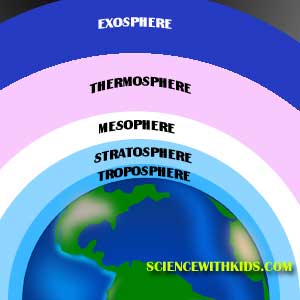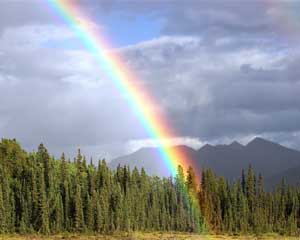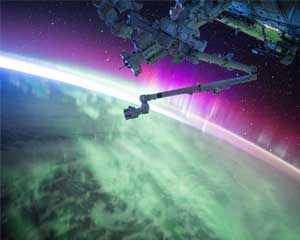Atmosphere Facts
Posted by Lauren M. / in Science Facts
 Layers of the Earth's atmosphere
Layers of the Earth's atmosphere
The Earth has a unique atmosphere
Facts about the Atmosphere
- The Earth has a unique atmosphere that supports life. No other planet or moon atmosphere has been yet discovered that is like the Earth's atmosphere.
- The atmosphere is made up of five different layers: the troposphere, the stratosphere, the mesosphere, the thermosphere, and the exosphere.

Earth's unique atmosphere supports plant and animal life
The Troposphere
- The troposphere is between 5 and 9 miles (8 to 14.5 kilometers) thick.
- Approximately 99 percent of the water vapor in Earth's atmosphere is in the troposphere.
- Most of the clouds we see in the sky are in the troposphere.
- The thickness of the troposphere is affected by latitude, seasons, time of day, and varies among regions.
- Humans, animals and all plants live in the troposphere.
- The troposphere the most dense layer of the atmosphere.
- Most atmosphere facts are measured in the troposphere. We have only began to collect more facts about the atmosphere since the inventions of lighter than air aircraft (balloons), airplanes, and space vehicles in the last 140+ years.
The Stratosphere
- The thickness of the stratosphere varies, but is generally about 20 miles (32 kilometers) thick.
- There are no clouds in the stratosphere so the amount of water vapor is very low.
- To avoid rough flights from clouds, most commercial airplanes fly in the stratosphere.
- Oxygen levels in the stratosphere are low.
- Some species of birds, such as the bar headed goose are capable of flying in the stratosphere.
- The ozone layer is found in the stratosphere, which is very important to people.
- The ozone makes sure that the right amount of UV radiation reaches Earth. Too much UV radiation can destroy tissue but it is important for the production of vitamin D in humans.

Airplanes fly in the Stratosphere to avoid air turbulence
The Mesosphere
- The thickness of the mesosphere is about 22 miles (35 kilometers).
- The mesosphere is the coldest layer of the atmosphere. The temperature of the mesosphere can drop as low as -220° F (-140°C).
- Atmosphere of the mesosphere is made up of carbon dioxide oxygen and nitrogen and is low density.
- The mesosphere is the layer of the atmosphere that protects the earth from meteors.
- The high atmospheric drag makes it impossible for researchers equipment such as satellites to stay in orbit in the mesosphere.
The Thermosphere
- The thickness of the thermosphere is about 319 miles (513 kilometers).
- The thermosphere can be very hot, over 3000° F. Even though the thermosphere is very hot it would feel cold because there are not enough molecules to transfer the heat to you
- The thermosphere is where the international space station and a lot of low lying satellites orbit the Earth.
- Scientists identify a layer overlapping the thermosphere and mesosphere, known as the ionosphere. This layer is over 500 miles thick and is very helpful to people for radiation. Also the ionosphere is helpful for radio wave communication on Earth.

The International Space Station orbits the Earth in the thermosphere
The Exosphere
- The thickness of the thermosphere is about 5800 miles (over 9300 kilometers).
- The exosphere is the outer layer of the Earth's atmosphere.
- Solar wind storms create pressure in the exosphere.
- The exosphere is ideal for placing satellites because there is very little friction so they are able to orbit easily.
- Only traces of oxygen and carbon dioxide can be found in the exosphere. The density of gas in the exosphere is very thin.
- The exosphere fades away in to space.
